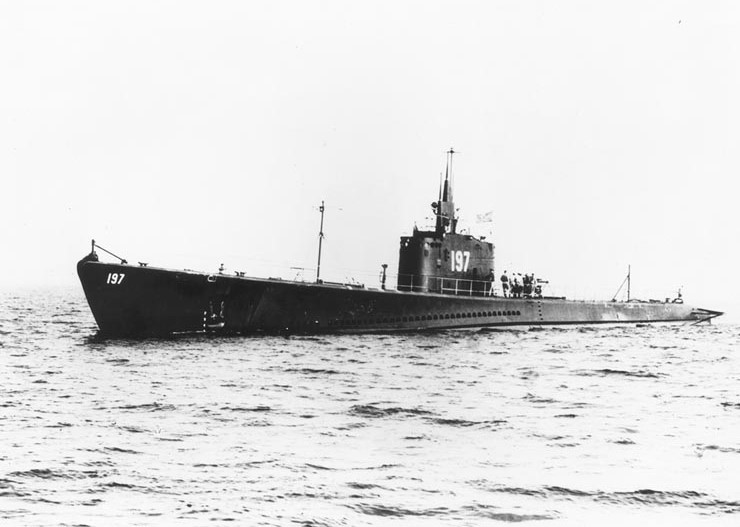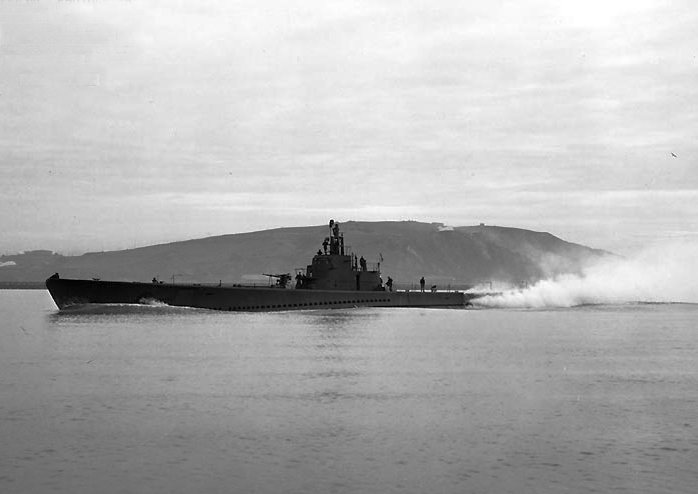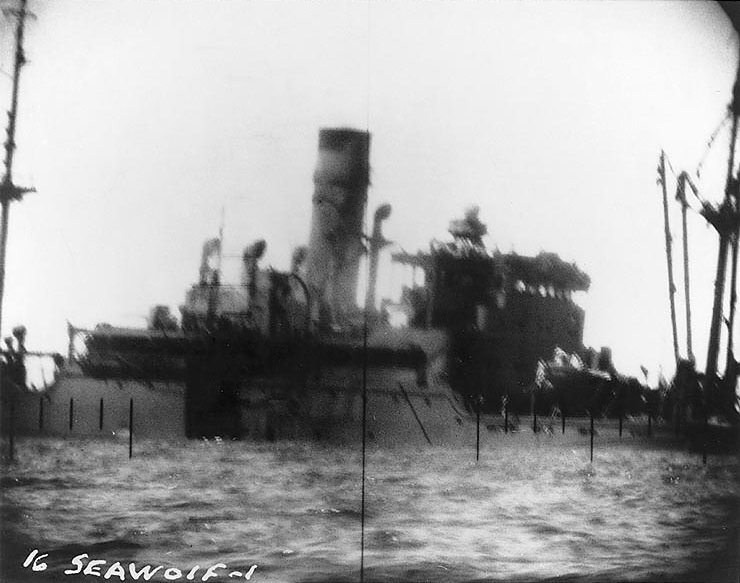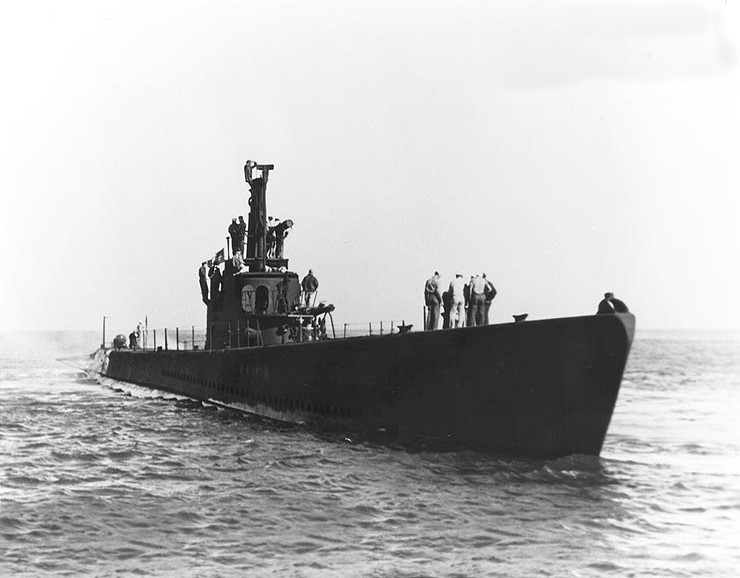USS Seawolf (SS 197)
When the Japanese attacked the Philippines at the beginning of World War 2, all of the defensive plans that had been painstakingly drawn out before the war fell by the wayside. The tragedy of Pearl Harbor ensured that the relief that was supposed to come and rescue in the aftermath of a Japanese incursion was not going to be available. The smoking hulks lying in the mud of Pearl Harbor bore a stark witness to that.
The one ace the Americans still held was the small but capable submarine force. Boats were strategically placed around the Pacific and were quick to answer the call. One of those submarines was the USS Seawolf. Like her sister boats in Pearl Harbor and elsewhere, she was ready to sail shortly after the attacks started.
From the Navy Department’s History of the USS Seawolf:
“This story has 80 heroes and one heroine. The heroes are the men of an American submarine. The heroine is the ship herself. More than 300 feet long, with eight torpedo tubes and a surface speed of better than 20 knots, she was commissioned 1 December 1939. Since that day, she led an exciting and secret life. During her fifteen war patrols, she sank approximately 110,000 tons of enemy shipping, covering the whole of the known Pacific shipping routes.”
Fleet Boats
The submarines were not originally designed for the missions they would ultimately undertake in the coming war. The evolutionary design of the American submarine brought them to this point however. Original designs were influenced by the US Navy’s General Board. In the beginning, their goal was to create s coastal defense submarine. These small boats used the technology of the day and had great limits. By the 1920’s, professional submariners were beginning to emerge and pushed the Board to understand that a fleet type boat was not only possible but would be a key part to future warfare. They also pushed to become more directly involved in the design of the boats. This was important because they were able to more quickly apply their visions with the emerging technology.
The Seawolf was a Sargo class submarine. In most features the Sargos were a repeat of the Salmons, except for the return to full diesel-electric drive for the last four boats and the adoption of the improved Sargo battery design. The first six Sargos were driven by a composite direct-drive and diesel-electric plant (two engines in each mode) in the same manner as the Salmons. In this arrangement, two main engines in the forward engine room drove generators. In the after engine room, two side-by-side engines were clutched to reduction gears which sat forward of the engines, with vibration-isolating hydraulic clutches. Two high-speed electric motors, driven by the generating engines or batteries, were also connected to each reduction gear.
The Bureau of Steam Engineering (BuEng) and the General Board desired a full diesel-electric plant, but there were some dissenting opinions, notably Admiral Thomas C. Hart, the only experienced submariner on the General Board, who pointed out that a full diesel-electric system could be disabled by flooding. Technical problems went against the use of two large direct-drive diesels in place of the four-engine composite plant. No engine of suitable power to reach the desired 21-knot speed existed in the US, and the current vibration-isolating hydraulic clutches were not capable of transmitting enough power. It was also not practical to gear two engines to each shaft. So a full diesel-electric plant was adopted for the last four Sargos, and remained standard for all subsequent conventionally-powered US submarines.
From commissioning until late 1941 the first six Sargos were based first at San Diego, later at Pearl Harbor. The last four were sent to the Philippines shortly after commissioning. In October 1941, the remaining Sargos and most other newer available submarines were transferred to the Asiatic Fleet in the Philippines as part of a belated effort to reinforce U.S. and Allied forces in Southeast Asia. The Japanese occupation of southern Indo-China and the August 1941 American-British-Dutch retaliatory oil embargo had raised international tensions.
After the Japanese attack on Pearl Harbor on 7 December 1941, the submarines of the Asiatic Fleet were the primary striking force available to Admiral Thomas C. Hart, the fleet’s commander. He was assigned sixteen Salmons or Sargos; the entirety of both classes. Seven Porpoise-class and six S-boats rounded out the force.[15] The Japanese did not bomb the Philippines until 10 December 1941, so almost all of the submarines were able to get underway before an attack. Sealion and Seadragon were the unlucky exceptions. In overhaul at the Cavite Navy Yard, Sealion was damaged beyond repair and was scuttled on 25 December. Seadragon, assisted by USS Canopus and USS Pigeon, was able to leave port with emergency repairs and went on to fight for most of the war.
The Sargo class was very active during the war, sinking 73 ships, including a Japanese submarine.
First Patrol
December 7th found the Seawolf on routine patrol. As word flashed across the Pacific that the attack occurred, Seawolf began her first war patrol on December 8th.
One interesting note from the day she began her patrol. I was a submariner for many years including in the Pacific Ocean. But as I read the Office of Naval Records and History account of the first patrol, the following paragraph stood out:
“Coins of all denominations flashed over the side into the water, in keeping with one of the many traditions which are so deeply rooted and have such a part in the submarine service. Their luck so assured, the men of the Seawolf took her down and went hunting.”
I had never heard of this tradition before but wish I had when I was actively riding boats. I think it would have been an awesome thing to do.
From the history:
“The searching prow of the sub nosed around northern Luzon, Babuyan channel and Bojeador Cape. Then on 14 December in the aft torpedo room four hisses of the tubes signaled the departure of four tin-fish. Skipper Warder got a last glimpse of the target, a Japanese seaplane tender, before the submarine dove. Scant seconds later, engine room men heard four muffled explosions. On the bottom – quiet reigned. But not for long; the concussion of nearby depth charges shook the Seawolf. For sixty plodding minutes the sickening boom of “cans” jarred the dormant submarine and then heavy silence again filled the ship. At last, assured that the angry surface vessels had gone their way, the Seawolf crept to the top, and finding the coast clear – returned to her home port.”
The ship that was attacked was actually the Sanyo Maru. On December 8, 1941 during Operation M the invasion of the Philippines operates off Singora (Songkhla) and on December 14, 1941 departs for Camranh Bay and while underway torpedoed by USS Seawolf (SS-197) and hit by a dud Mark-14 steam torpedo that caused only slight damage.
On August 6, 1941 Sanyo Maru had been requisitioned by the Imperial Japanese Navy (IJN) at Sasebo. The vessel was converted to begin conversion to a 8 seaplane carrier/tender, with two 150-mm/45 cal single-mount guns, two Type 93 13mm machine guns and a catapult are installed. The conversion was completed on August 15, 1941, and she was re-designated as a seaplane tender carrying six F1M2 Pete and two E13A Jake and two E8N2 Dave.
Sinking History
On May 24, 1944 Sanyo Maru departed Manila via Cebu carrying about 600 men of an anti-aircraft unit bound for Kao on Halmahera. On May 26, 1944 Sanyo Maru was north-northwest of Manado (Menado, Mendao) in the Celebes (Sulawesi) when hit by four torpedoes from a spread of five fired by the USS Cabrilla (SS-288). One torpedo hits the starboard No. 4 hold, another hit the No. 6 hold. The explosions killed thirty-five men of the anti-aircraft unit. At 5:32pm, she is abandoned. At 7:40pm, the ship sinks at approximately Lat 2° 46′ N Long 124° 22′ E. Officially removed from the Navy list on July 10, 1944.
26 December 1941 Manila
From Navy Communication No. 18: Manila has been declared an open city as defined in Hague Convention (IV) of 1907, Annex, Article 25. Our forces have complied with the stipulations of that convention.
Seawolf departed Manila on 31 December 1941 for Australia and arrived at Darwin on 9 January 1942. She loaded 30–40 tons of .50 cal (12.7 mm) antiaircraft ammunition for use by American forces on Corregidor and sailed for Manila Bay on 16 January. The submarine sighted seven Japanese freighters accompanied by four destroyers and a cruiser on 21 January, but had no opportunity to fire any of the eight torpedoes that she had aboard. The ammunition was unloaded on 28–29 January at Corregidor. Seawolf then loaded torpedoes and passengers, and headed for Surabaya, Java.
Navy Communication No. 23 JANUARY 2, 1942
The U. S. naval base at Cavite was evacuated before the enemy entered Manila. All records, equipment, and stores that were not destroyed by bombing were removed prior to evacuation by naval personnels. All industrial and supply facilities, including fuel, were destroyed. The personnel of the naval hospital remained at their posts at the Naval Hospital, Canacao, to care for the wounded. All ships and naval personnel were removed from the Manila-Cavite area prior to enemy occupation. There is nothing to report from other areas.
Seawolf would go on to conduct a total of fifteen war patrols.
Fifteenth war patrol and loss
Seawolf stood out of Brisbane on 21 September to begin her 15th war patrol under the command of Lieutenant Commander Albert Marion Bontier. She reached Manus Island on 29 September, refueled, and sailed the same day carrying stores and Army personnel to the east coast of Samar.
Seawolf and Narwhal exchanged radar recognition signals at 0756 on 3 October in the Morotai area. Shortly thereafter, a 7th Fleet task group was attacked by Ro-41. The destroyer escort Shelton was torpedoed and sunk, and Richard M. Rowell began to search for the enemy.
Since there were four friendly submarines in the vicinity of this attack, they were directed to give their positions and the other three did, but Seawolf was not heard from. On 4 October, Seawolf again was directed to report her position, and again she failed to do so. One of two planes from the escort carrier Midway sighted a submarine submerging and dropped two bombs on it even though it was in a safety zone for American submarines. The site was marked by dye. Rowell’s commanding officer knew he was in a safety lane, but, having failed to get word Seawolf was behind schedule, believed there was no U.S. submarine nearby and chose to attack. Rowell established sonar contact on the submarine, which then sent a series of dashes and dots which Rowell stated bore no resemblance to the existing recognition signals. Believing this an attempt to jam her sonar, Rowell attacked with Hedgehog. The second attack was followed by underwater explosions, and debris rose to the surface.
On 28 December 1944, Seawolf was declared overdue from patrol and presumed lost. She was stricken from the Naval Vessel Register on 20 January 1945.
Post-war examination of Japanese records shows no attack listed that could account for the loss of Seawolf. While it is possible Seawolf was lost to an operational casualty or as a result of an unrecorded enemy attack, it is more likely she was sunk by friendly fire. 83 officers and men as well as 17 Army passengers were lost. She was the thirty-fourth U.S. submarine lost in the Pacific War, the second (after Dorado in the Caribbean) to friendly fire. One of the Army passengers was Captain Howell S. Kopp, an Alamo Scout. Kopp was en route to an undisclosed location in the Philippines to conduct a clandestine mission in support of the upcoming Allied landing on Leyte.
Seawolf received 13 battle stars for World War II service. She ranked fourteenth in confirmed tonnage sunk (71,609 tons) and tied for seventh in confirmed ships sunk (with Rasher and Trigger), according to the JANAC accounting postwar.
The contributions and sacrifices of Seawolf and her crew are officially commemorated in Seawolf Park, located on Pelican Island, just north of Galveston, Texas.
Seawolf was awarded two Navy Unit Commendations for her patrols. From one of the citations:
Heroes are not born to be heroes. But in some cases, they rise to the occasion.
http://www.oneternalpatrol.com/uss-seawolf-197.htm
The men who answered the nation’s call and took the fight to the enemy on submarines are truly heroes on a grand scale.
Mister Mac





I have vague remembrances of throwing coins in the water at a Sub Base pier in Key West in 1966 for the USS Tirante (SS-420). The wives were giving the children coins to throw in the water as the boat was pulling out. When I asked what they were doing, I was told that it was Good Luck to pay a toll to Neptune for the sub’s safe return. It was our first boat — the rest were nucs — and the only time I ever heard about anyone doing it.
Thanks. I am sure it was real, but it’s sad that the tradition was lost somehow. I am sure there were others.